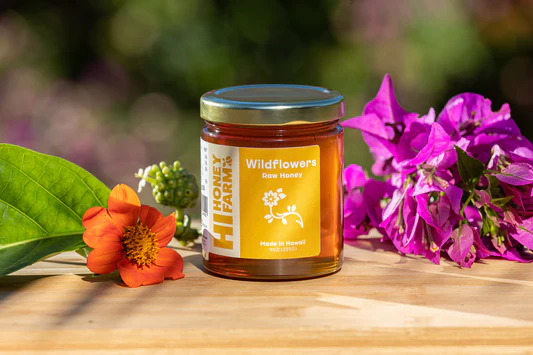Introduction
Welcome to the enchanting world of Hawaiian honey, where nature’s golden treasure thrives amidst the breathtaking landscapes of the Pacific paradise. Hawaii, renowned for its stunning beaches, lush rainforests, and vibrant culture, is also a haven for honey enthusiasts. In this article, we delve into the fascinating world of “Honey from Hawaii,” exploring its diverse flavors, health benefits, sustainable practices, and the beekeeping traditions that have been cherished for generations.

The Blossoming Diversity of Hawaiian Honey
Hawaii, a melting pot of unique geographical features and microclimates, offers an astounding array of honey varieties. One of the most sought-after is Lehua honey, extracted from the vibrant red blossoms of the native Ohia tree. This delicate, light-colored honey carries the essence of the pristine rainforests that blanket the islands, captivating both locals and visitors alike.
In stark contrast, Macadamia nut honey boasts a robust, nutty flavor. Derived from the nectar of Macadamia tree flowers, this dark amber honey embodies the essence of the islands’ rich agricultural heritage, reflecting the harmony between man and nature.
Other notable Hawaiian honey varieties include the multi-floral Wilelaiki honey, the aromatic Eucalyptus honey, and the exquisitely rare Kiawe honey. Each type originates from a specific plant’s nectar, allowing connoisseurs to embark on a unique and delectable tasting journey through Hawaii’s diverse landscapes.
The Health Benefits of Hawaiian Honey
Beyond its exceptional taste, Hawaiian honey offers a treasure trove of health benefits. Enriched with antioxidants, essential vitamins, and minerals, this natural elixir provides a wholesome and nourishing addition to one’s diet. The presence of enzymes aids in digestion, promoting a healthy gut and overall well-being.
A special mention goes to Kiawe honey, a monofloral variety that exhibits exceptional antimicrobial properties. Revered in traditional Hawaiian medicine, Kiawe honey has been used to alleviate sore throats and minor wounds, demonstrating the unique healing properties that honey from Hawaii can provide.
With low moisture content and high acidity, Hawaiian honey is remarkably resistant to spoilage, ensuring a long shelf life while maintaining its nutritional integrity. This makes it a popular choice for health-conscious consumers seeking an alternative to processed sweeteners.
Sustainable Beekeeping Practices in Hawaii
Amidst the lush landscapes of Hawaii, beekeepers embrace a commitment to sustainable practices, recognizing the delicate balance between nature and human endeavors. Organic hive management plays a vital role in ensuring the well-being of the bees and the purity of the honey they produce.
Beekeepers carefully select the sites for their apiaries, considering factors such as native plant availability and minimal exposure to harmful chemicals. This conscientious approach not only protects the bees but also contributes to the preservation of Hawaii’s unique ecosystems.
Responsible harvesting methods are paramount to maintaining a healthy bee population. Beekeepers leave enough honey reserves for the bees to thrive during the leaner seasons, fostering the resilience of the colonies and minimizing stress on the delicate pollinators.
Moreover, beekeepers collaborate with conservationists and environmental organizations to support habitat restoration and the protection of native plants, which are crucial to the bees’ survival and the exceptional flavors of Hawaiian honey.
The Cultural Significance of Bees in Hawaiian Tradition
Bees have held a place of profound significance in Hawaiian culture for centuries. Considered as “na makani a’o Pele” or “the winds of Pele” (the volcano goddess), they are revered as sacred messengers and embody the spirit of the land.
In ancient times, honey played a central role in various rituals and ceremonies. From religious offerings to medicinal concoctions, the Hawaiians cherished honey for its spiritual properties and potent healing qualities.
Beekeeping was considered an art form, passed down through generations. Beekeepers, known as “mahiki,” were highly respected members of the community, and their skills were honed through years of apprenticeship and experience.
Today, while modernization has touched every aspect of Hawaiian life, the cultural reverence for bees and honey remains steadfast. Beekeepers take great pride in continuing the age-old traditions and preserving the deep-rooted connection between the people of Hawaii and these extraordinary insects.
From Hive to Table: The Honey-Making Process
The journey of Hawaiian honey from hive to table is a fascinating and intricate process that involves the collaboration of the bees, beekeepers, and nature itself.
It all begins with the honeybee’s tireless efforts to collect nectar from the abundant flowers across the islands. The bees transform the nectar through a process of regurgitation and evaporation, adding enzymes to convert it into honey. This remarkable alchemy takes place inside the wax comb structures they create within the hive.
The beekeeper’s role is to ensure the hives remain healthy and thriving. Regular inspections help monitor the bees’ progress, ensuring they have ample space to store honey and raise their young. During the harvesting season, beekeepers carefully extract the surplus honey, leaving enough for the bees to sustain themselves.
Preserving the raw, unfiltered essence of Hawaiian honey is a priority for beekeepers. They avoid excessive heating or processing, which might compromise the honey’s natural flavors and health benefits. Instead, the honey is gently strained or cold extracted to retain its unique qualities, including the presence of pollen, propolis, and other beneficial compounds.
After harvesting, the honey is carefully packaged and labeled, ready to find its way to homes, markets, and gourmet kitchens, where it will add a touch of the islands’ magic to every culinary creation.
Honey from Hawaii in Modern Cuisine
The culinary world has fallen in love with the distinctive flavors of Hawaiian honey. Renowned chefs and home cooks alike seek to incorporate its unique profiles into a myriad of dishes.
In breakfast delights, Lehua honey drizzled over pancakes or mixed into yogurt adds a burst of floral sweetness. Macadamia nut honey finds its way into savory dishes like glazes for grilled meats, infusing them with a nutty depth that elevates the overall flavor.
Beyond the traditional pairings, honey from Hawaii finds its place in innovative culinary creations. Trendsetting restaurants experiment with using different honey varieties as a key component in cocktails, dressings, and dessert preparations, where the sweet nectar becomes a canvas for creative expression.
As Hawaii’s reputation for exceptional honey continues to grow, its impact on the culinary world is undeniable, bringing a touch of paradise to dishes served on dining tables worldwide.
Eco-Tourism and Honey Tasting in Hawaii
For those seeking an immersive experience into the world of Hawaiian honey, eco-tourism offers a gateway to the magical realm of bees and beekeeping.
Guided tours take visitors on a journey through carefully selected apiaries, offering an up-close encounter with the fascinating lives of the bees. Expert beekeepers share their knowledge, explaining the bees’ role as pollinators and the significance of their conservation.
Honey tasting sessions are a highlight of these tours. Participants savor the diverse flavors of Hawaiian honey, guided by experts who explain the unique characteristics of each variety. This sensory exploration provides a deeper appreciation for the work of the bees and the efforts of the beekeepers that culminate in the delectable nectar.
The tours are often set amidst Hawaii’s stunning natural landscapes, making them an unforgettable experience for nature enthusiasts and those seeking a deeper connection with the environment.
Conclusion
Honey from Hawaii, with its blossoming diversity of flavors, remarkable health benefits, sustainable practices, and cultural significance, is a golden thread that weaves together the rich tapestry of this Pacific paradise. Beekeepers’ dedication to preserving nature’s harmony, the bees’ tireless work, and the enchanting flavors they produce are a testament to the beauty and depth of Hawaiian honey.
As this elixir continues to captivate hearts and palates worldwide, let us embrace and celebrate the legacy of honey from Hawaii. From the sacred honey ceremonies of old to the modern culinary innovations, Hawaiian honey remains an emblem of harmony between humankind and nature.
Embracing the legacy of Hawaiian honey means recognizing the delicate ecosystem that sustains its production. Conservation efforts are paramount in safeguarding the native plants and flowers that provide the bees with the nectar they transform into liquid gold. Collaborations between beekeepers, environmental organizations, and local communities work towards preserving Hawaii’s fragile biodiversity and ensuring a flourishing future for the bees.
Additionally, supporting local beekeepers and purchasing Hawaiian honey directly from them helps sustain the time-honored tradition of beekeeping on the islands. By doing so, consumers contribute to the well-being of beekeeping families and their dedication to maintaining sustainable practices that respect the environment.
Hawaii’s honey culture is a true reflection of the islands’ spirit—a spirit that values the interconnectedness of all living beings and cherishes the gifts that nature bestows upon us. From the remote farms nestled in the lush valleys to the bustling markets in the cities, the presence of honey from Hawaii serves as a reminder of the islands’ natural abundance and the importance of preserving it for generations to come.
As the world becomes increasingly aware of the importance of sustainable practices and the impact of human activities on the environment, Hawaiian honey stands as a beacon of hope. It reminds us that, even in the face of modern challenges, it is possible to nurture a harmonious relationship with nature and preserve the unique gifts it offers.
In conclusion, “Honey from Hawaii: Nature’s Golden Treasure Amidst the Pacific Paradise” is not just a delectable treat but a symbol of the islands’ cultural heritage, sustainable practices, and the deep-rooted connection between Hawaiians and their natural surroundings. From the diverse flavors that tantalize the taste buds to the health benefits that nourish the body, Hawaiian honey continues to captivate the world.
Let us celebrate the dedication of Hawaiian beekeepers, the industriousness of the bees, and the enchanting flavors they create. As we savor each drop of this liquid gold, let it be a reminder of the delicate balance between humankind and nature and the responsibility we bear to protect the environment for future generations.
So, whether you are a seasoned honey connoisseur or just discovering the wonders of Hawaiian honey, take a moment to immerse yourself in its story—a story of beauty, sustainability, and the sweetest gifts from paradise itself. In the end, “Honey from Hawaii” is not just a key phrase, but an invitation to embark on a journey of discovery and appreciation for the remarkable world of Hawaiian honey.

